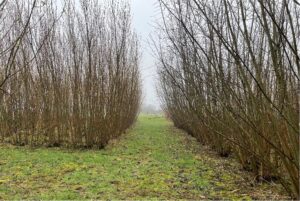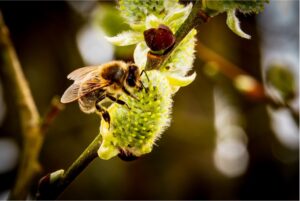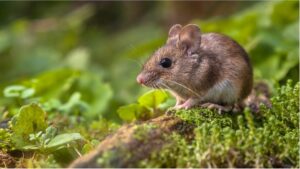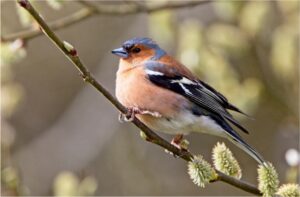How does Short Rotation Coppice (SRC) willow affect biodiversity?
Take home messages:
- SRC willow plantation supports high plant and animal species diversity in comparison with arable lands.
- The abundance and richness of biodiversity in SRC willow is associated with the crop and its management, the plantation size and layout design, and interaction with surrounding landscapes.
- Planting different small multi-genotype plots and different age classes of SRC willow, with different coppice rotation enhances biodiversity.
- SRC Willow stand edges have high plant and animal species diversity compared to stand edges on arable agricultural land.
- The low input use and low soil disturbance after establishment of SRC willow plantation provides a conducive environment for many plant and animal species to survive.
Introduction
The production of biomass crops such as short rotation coppice (SRC) willow, is an important part of the UK’s Net Zero strategy to generate more homegrown power and electricity. SRC willow biomass has the potential to be converted into renewable energy. SRC willow is a short rotation woody crop that rapidly produces large amounts of renewable biomass when harvested every two to five years. It provides environmental benefits of minimizing soil erosion and also increases wildlife habitat and biodiversity for birds, pollinators, and small mammals. Despite the expansion potential of the SRC willow, the large-scale deployment of willow is hampered by growers and public concerns that the extensive commercial production of SRC willow could have negative effects on biodiversity. In this article, we provide insight on the dynamics of interaction of SRC willow and its effect on plant and animal biodiversity.
SRC willow and plant diversity
SRC willow contributes to plant diversity when integrated into existing landscapes and farming systems. Studies have shown that SRC willow plantation supports high plant species richness and abundance in comparison with arable lands. For example, a study found 27% greater plant species richness (133 flora species) and greater weed cover on SRC willow plantation when compared to the neighbouring arable agricultural land. The low input use and low soil disturbance after establishment of SRC willow plantations provides a conducive environment for many plant species to survive.
Plant species obtain all their habitat needs from the place where they establish on the SRC willow plantation. Plant species colonization on the SRC willow plantation takes place from the surrounding plantation, seed bed bank, and through living vegetation tissues like rhizomes, tillers, or living roots in the soil. In the initial years of establishment, the plant diversity is like that of arable agricultural land, and as the SRC willow plantation ages, the plant diversity evolves to deciduous forest, if the willow plants are not regularly coppiced.
The layout and size of the SRC willow plantation and its interaction with surrounding landscapes affect plant biodiversity. Effective site preparation in the establishment of SRC willow plantation requires well laid-out planting design and staging area to facilitate the use of farm machinery. Studies suggest having small multi-genotype SRC willow plots within a plantation with different coppice rotation times to enhance biodiversity. A study showed that plant species richness increased with increasing size of a SRC plantation but only until a size of 0.1–0.3 ha was reached. Different genotypes of the willow plant differ in the morphology of shoot, branches, and leaves. This creates niches for diverse plant and animal habitats.
Furthermore, the plant density of the SRC willow influences the dynamics of the canopy closure which influences the plant species richness and abundance. In the initial years of establishment of SRC willow plantation, more light demanding plant species, usually annual species with shrub-like herbaceous structure, grow on the field. As the canopy further closes with increasing age of the SRC willow, more shade tolerant perennial plants typical of forest grow on the field. Coppicing rotation length as well affects the canopy structure, thus, evolving from a bare field initially colonized by herbaceous plants initially after coppicing and as the canopy closes, more shade loving forest types of plants colonize the plantation.
The stand edge and pathways in SRC willow plantation used as open spaces to facilitate use of farm machinery and to serve as physical barrier on largescale plantation, provide a habitat for diverse plant species. SRC Willow stand edges have high plant diversity and species richness when the stand edge is allowed to develop with naturally occurring vegetation, or when purposefully sown with grasses or herbaceous seeds. Studies report higher plant population and species richness density at the edge of the SRC willow plantation than in arable stand edges. Biodiversity in the willows can also be enhanced by planting and managing a diverse mixture of herbaceous plants in the stand edge and pathways that immediately surround and allow access to the willow crops. Wider stand edges of six metres or more will be less shaded and support more plant species.
Other studies have shown interactions of the SRC willow plantation with other surrounding landscapes influences plant biodiversity. The more diverse the surrounding landscape, the more species can establish in the plantation. Establishing smaller plantations with longer stand edges facilitates species from the surrounding landscape more than larger plantations.
SRC willow and animal diversity
Bird and mammal species found in SRC willow plantation are typical of open field and woodlands. Young plantation attracts birds and animals associated with open fields, where over time as the willow ages and increases in height, it attracts forest associated animals. The dynamic habitat characteristic of willow provides different function to different species over time. Unlike plant species where the place of establishment on the willow field provides all the nutrients needed by the plant, animals seldom rely completely on SRC willow for fulfilling all their habitat needs. They use the willow for one or more functions of shelter, nesting, and foraging.
Different genotypes of willow grow in different ways and create different habitat attracting different animals. For instance, branching attracts certain types of bird species, and the herbaceous structure of the willow during the initial years of establishment attracts small mammals and insects. The surrounding landscape and stand edge of the SRC willow plantation support higher species richness abundance of invertebrates and birds. Willow plantation provides wildlife corridors connecting adjacent and fragmented landscapes which is beneficial for creating habitat for certain species and a conduit for movement for biodiversity.
Insects
SRC willow plantations provide habitat and sustenance for a large diversity of insects such as bees, spiders, butterflies and ground beetles. Studies have shown that more insects live on willow than other tree species. Willow provides pollen early in spring for bees to build their colony. The willow male catkins produce pollen, and the female catkins produces pollen and nectar that bees and other pollinators forage for food. Willow sex is important factor in bees visitation differences. A study found male willow supporting greater abundance, more richness and greater diversity of bees. However, only a few male varieties are currently available – Cheviot, Sven, Olof and Wilhelm. Most are females so these only provide nectar. Furthermore, some of the highest yielding varieties e.g. Endurance are sterile so offer no benefit to bees. Different willows flower at different points – late January to early April, hence careful selection of both male and female willow is important to provide pollen at different flowering times for pollinators over an extended period.
Furthermore, the less disturbance to the soil after establishment, favours earthworm populations. Other studies have found arthropod activity densities significantly higher, sometimes almost double, in SRC willow plantations. Species richness and abundance of butterflies as well increased in SRC willow plantation when compared to arable lands. Likewise, SRC willow has been found to have a positive effect on ground beetles and arachnids biodiversity quality.
Use of pesticide is a known factors for decline in insect abundance and diversity. The low input use in SRC willow management allows for many insect species to flourish. Landowners and land managers should consider biological control of insects over the use of insecticides to enhance insect diversity on willow plantation.
Mammals
Willow plantations have a high abundance and richness of mammals such as wood mice (Apodemus sylvaticus), common shew (Sorex araneus), field vole (microtus agrestis) and many others. The herbaceous nature of willow plant structure between planting and the first coppicing, and thereafter the plant growth after each coppicing cycle provides a semi-long term habitat for mammal species associated with open fields and meadows. Studies have shown that more small mammal species used willow in the year following coppicing because of the herbaceous undergrowth. Coppicing allows undergrowth abundance of weeds flora which provides food for small mammals. For example, a UK study indicated that willow is a good habitat for small mammals when the willow plantation is allowed to become weedy.
Willow provides small mammals with all their habitat needs as they have a small spatial niche which willow plantations size can provide. Large mammals on the other hand have a wider spatial niche which the willow plantation may not necessarily be able to cover and must depend on surrounding landscape for their habitat demands to survive. Studies have shown that dominant small mammals from adjacent forest survive in willow.
Birds
Willow plantation attracts numerous woodland and other types of bird species such as Chaffinch, long-tailed tit, Robin, Blackbird, Sparrowhawk and many others including some endangered bird species. A survey of SRC plantation in Wales recorded 25 bird species both in the breeding season (April – September) and winter, sighting birds such as Blackbird, Goldfinch, Redpoll, and Song thrush, nesting in SRC willow plantation. Birds are more abundant in the edges of the SRC willow than the stand edges around arable agricultural lands. Studies have reported fewer bird populations in the interior of large SRC willow plantation than the hedgerows.
The abundance of bird species is associated with the age, coppice stem, planting density, and weed cover in the SRC willow plantation. Different bird species select different age classes of SRC willow for their habitat needs. The age of SRC willow affects the height, canopy cover and ground cover. While more small mammal species tend to use willow crops in the year following coppicing because of their herbaceous undergrowth, more birds tended to use older willow crops. Planting different age classes of willow within a plantation will provide diverse habitat for various birds, thus maximizing the abundance and species diversity of birds.
Studies have shown that bird nesting habitat can be improved by including varieties of SRC willow in which birds preferentially nest. Also, planting different genotypes of SRC willow and a greater density has a positive effect on bird population. The surrounding landscape of SRC willow plantation influences the bird composition found in the SRC willow plantation. Studies suggest SRC willow next to different habitat types such as forests to maximize the bird species richness and abundance.
SRC willow management considerations
SRC willow plantation should be planned and managed to create a positive impact on biodiversity. Landowners and managers should consider the following;
- Wider stand edges of at least 6m in width should be incorporated in the design of the SRC willow plantation. There should be active management of the SRC willow stand edges by allowing naturally occurring plants to colonize the stand edges or purposively planting seeds to maximize plant biodiversity and support diverse animal diversity such as pollinators and small mammals.
- Establish small multi-genotype stands of SRC willow within a plantation with different coppice rotation times to enhance biodiversity.
- Encourage growth of weed species in SRC willow plantation after the establishment phase of the plants. The weed cover attracts diverse animal and plant species.
- Plant different age classes of SRC willow and increase the planting density on the field to enhance the structural and functional diversity and create diverse niche habitat for various species of plants and animals.
- Minimize or avoid insecticide use as the insecticides affect the biodiversity and the environment adversely.
- Minimize or avoid pesticide use on the nontarget invertebrate population and preferably use biological control.
Conclusion
SRC willow has a positive effect on plant and animal biodiversity. The abundance and richness of biodiversity in SRC willow is associated the crop and its management, the plantation size and layout design, and interaction with surrounding landscapes. The low input use and low soil disturbance after establishment of SRC willow plantations provides a conducive environment for many plant and animal species to survive. Planting different small multi-genotypes plots and different age classes of SRC willow with different coppice rotation enhances biodiversity. SRC Willow stand edges has high plant and animal species richness and abundance. There should be active management of the SRC willow stand edges by allowing naturally occurring plants to colonize the stand edges or purposively planting seeds to maximize plant biodiversity and support diverse animal species such as pollinators and small mammals.







